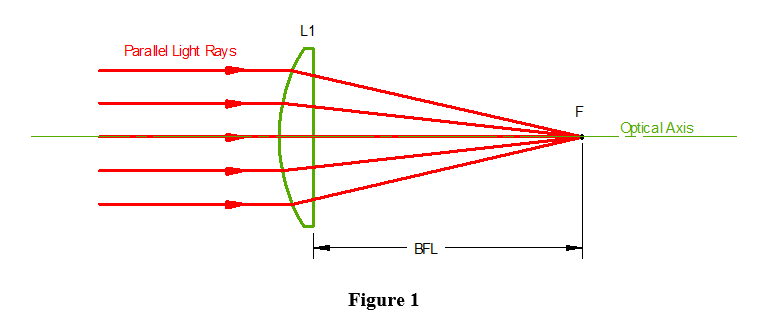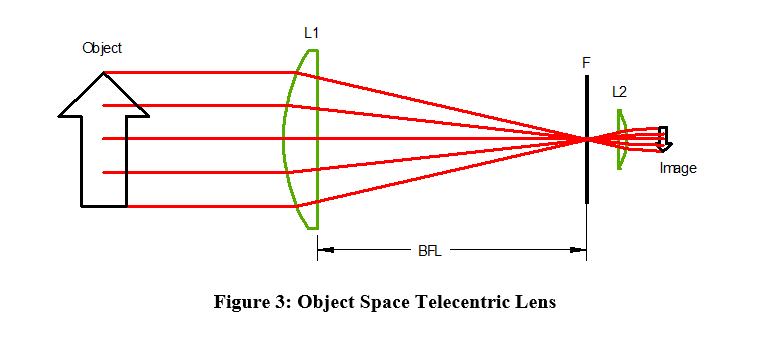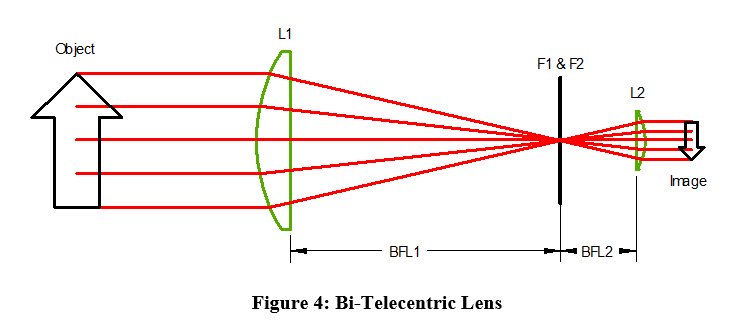Bi-Telecentric Lenses
We've talked about telecentric lenses in general elsewhere, and have even touched on bi-telecentric lenses in our FAQ page. There we've mentioned Object Space Telecentric (OST) Lenses, Image Space Telecentric (IST) Lenses, and Bi-Telecentric (BT) Lenses. But what makes a bi-telecentric lens? (Sometimes they're also called double-telecentric lenses.)
First, let's review what we mean by telecentric at all:
Figure 1 shows an ideal lens L1, with light rays parallel to the lens Optical Axis entering it. After these rays are refracted by L1, they converge to a single point called the focus, F, of the lens. This is the definition of F.

The distance from the back of the lens to F is called the Back Focal Length, BFL.
If we place a small aperture right at F, then any rays of light entering the lens that are NOT parallel to the Optical Axis will be blocked. See Figure 2.

If we then place a second lens, L2, past the aperture, and L2 is of the right type and position, it can form an image of an object placed in front of L1. This arrangement is called an Object Space Telecentric (OST) lens because the rays of light from the object to the first lens are all (mostly) parallel to the Optical Axis. See Figure 3.
This provides a great advantage over a conventional lens. Unlike with a conventional lens, the object can be moved closer or farther from the OST lens, and still appear to be very nearly the same size. That is, the image remains nearly the same size over quite a long range of motion. This good for gauging applications. The range over which an object can move and still have the image be of an acceptable size is called the Magnification Depth of Field, or MagDOF. This is different than the traditional Depth of Field (DOF), which is a measure of how far an object can move and still be in acceptable focus.

If instead of placing the aperture at the focus, F1, of L1, we placed the aperture at the back focus of just L2, this would be an Image Space Telecentric (IST) lens. The actual applications for such a lens are limited, and usually not of interest in machine vision applications. We don't show a figure for this.
But, if we arrange things so that the same aperture is at the focus F1 of L1 while at the same time being at the focus F2 of L2, this creates a Bi-Telecentric lens. It's telecentric in both Object Space and Image Space. See Figure 4.
A Bi-telecentric lens accepts only rays of light from the object that are mostly parallel to the Optical Axis, while also limiting the rays of light that leave the last lens (and thus contribute to the image) to being mostly parallel to the Optical Axis.
So why does it matter?
As it turns out, a Bi-telecentric lens has a much greater range that the object can move and still have the image appear to be nearly the same size. It has a greater MagDOF. This makes for a much better lens for high accuracy gauging. As a matter of fact, if such a system could be designed and manufactured perfectly, the object could move any distance and still appear to be exactly the same size. It would have infinite MagDOF. In reality, of course, no such system can be made. Furthermore, a Bi-telecentric lens is still subject to defocusing if the object moves too far, just like a conventional lens. So while the image might remain the same size, it would eventually get too blurry to be useful, even for a perfectly designed and manufactured Bi-telecentric lens.

So why aren't all telecentric lenses made as Bi-telcentric? One reason is that designing and manufacturing such lenses is a bit more difficult, and thus more expensive. There are many applications that don't require such high MagDOF values. Another reason is that Bi-telecentric lenses must generally be longer than OST lenses of the same performance.
Light Works' line of Super-EyeTM telecentric lenses are all Bi-telecentric. We have a wide range of standard designs, but as with almost all of our products, we're able and happy to customize for your specific needs. Just contact us!
Frequently Asked Questions
1. What's the difference between a telecentric lens and a bi-telecentric lens?
A telecentric lens in general is one that either a) only receives rays (cones) of light that are mostly parallel to the lens optical axis, b) only emits to the image plane rays (cones) of light that are mostly parallel to the lens optical axis, or c) does both.
The first case a) is called an Object Space Telecentric (OST) lens. The second case b) is called an Image Space Telecentric (IST) lens. The third case c) is called a Bi-Telecentric or Double Telecenric lens.
From this you can see that all Bi-Telecentric lenses are telecentric, but not all Telecentric lenses are Bi-Telecentric.
Most industrial uses of telecentric lenses are limited to either OST or Bi-Telecentric lenses.
Generally, OST lenses are a little shorter, and a little less expensive than equivalent Bi-Telecentric lenses.
2. Are Bi-Telecentric lenses better than OST telecentric lenses?
It depends on what you mean by better. As noted, a Bi-telecentric lens is usually longer and more expensive than an equivalent OST lens. So if price or space savings is critical, then the answer is no.
But if maintaining a nearly constant magnification while the object changes distance from the lens is important, then a Bi-telecentric lens is definitely better.
The following table compares a conventional lens to an OST lens to a Bi-Telecentric lens, all set up for a beginning magnification of -0.250X, and operating at about F/14. Then the object distance is changed and the magnification is re-calculated for each change without re-focusing the lens.
Object distance change Conventional lens (100mm fl.) mag. change OST lens (100mm fl.) mag. change Bi-Telecentric lens mag. change
+10mm -1.9% -0.12% 0.00%
+20mm -3.7% -0.24% 0.00%
+30mm -5.5% -0.36% 0.00%
The measure of how much the object distance can change for a given magnification change is called the Magnification Depth of Field, or MagDOF. This is different than "normal" Depth of Field (DOF) which is related to how much the object distance can change before the image gets too de-focused to be useful.
As you can see, while the OST lens has much less change in magnification than a conventional lens, the Bi-Telecentric lens has no change at all! Hypothetically, a Bi-Telecentric lens could have infinite MagDOF.
In practice, there are two things to keep in mind. The first is that while MagDOF might be very large, in most every case the "normal" DOF becomes the limiting factor if the object distance changes significantly.
The second thing to keep in mind is that infinite MagDOF is only achievable for perfectly designed, perfectly assembled and aligned Bi-Telecentric lenses. Real Bi-Telecentric lenses always fall short of this ideal, but they are still superior to OST lenses.
3. Do Bi-telecentric lenses have lower distortion than OST lenses?
The short answer is no. Both types can be designed with high or low distortion. Generally, low distortion designs of either type will be more expensive. This is the same as for conventional lenses.
4. Why is there no focal length specification for Bi-Telecentric lenses?
This is because a true Bi-Telecentric lens has infinite focal length. This might be hard to conceive, but it's true. It's also one way of explaining why Bi-Telecentric lenses have such great MagDOF. If you were to create a conventional lens with a very, very large focal length, then a small change in object distance (such as 10, 20, or 30mm shown above) would result in a very small change in magnification. An infinite focal length conventional lens would have infinite MagDOF. But in such a case, the object would have to be infinitely far away to be in focus at all!
